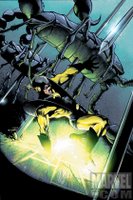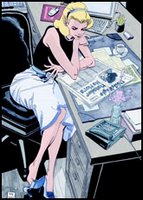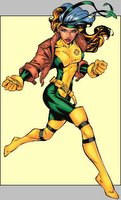 Carol Susan Jane Danvers, Ms. Marvel/Binary/WarbirdFirst appearance:
Carol Susan Jane Danvers, Ms. Marvel/Binary/WarbirdFirst appearance: Marvel Super-Heroes #13
Current status: balancing her time between regular life and being a superheroine
Was subjected to the following acts of discrimination: in The Avengers #197-200, she was teleported to limbo by Marcus, the son of Immortus, an alternate version of Kang the Conqueror, where she came under his mind-control effects, becoming a love-slave. Then, in a most creepy Oedipus Rex-like storyline, the villain stored himself inside Carol’s body, in an attempt to emerge in the regular world and then build a machine with which he could ensure that he’d be able to continue life normally – and quite likely also to conquer. Plus, there was also the part in
Avengers: Disassembled in 2004 where she said that she hated Scarlet Witch, which was out of character.
What’s wrong with how this was done? At the time it first went to press, the problem with it is that it seemed almost intended for weak shock value effect (and even under mind-control, one of the things Carol said to Marcus sounded in very poor taste). And, when it was first written, put together from a story Jim Shooter had actually come up with (yes, one of a few questionable stories he’d been responsible for drafting, assigning other writers like David Michelinie to fully develop), there was a line there that may have slipped under the radars of many: however subtly he did it, Marcus had actually admitted that he’d brainwashed Carol when he said she’d gotten a
“subtle boost from the machines.” Given that she was still under mind-control, it’s understandable that Carol would fail to realize what was going on, but that the other Avengers who were witness to Marcus’ explanations would be oblivious to what he was saying was quite bizarre, and, on the scriptwriting surface, downright sloppy.
Was there anything good to come out of this? Surprisingly enough, yes! When Chris Claremont, who’d written her 1977-79
Ms. Marvel series, wrote the 10th Avengers Annual in 1981, which went to press a few months after the storyline with Marcus Immortus, he made more sense out of it than Michelinie or even Shooter himself had when they first put it together. As Carol told the Avengers following their foiling of the Brotherhood of Evil Mutants’ attempted breakout from prison in New York, Marcus had actually put her under mind-control, and, after his miscalculations led to his speedy demise, within the time of about a week since Thor returned them to limbo, she was free of the effects, and realized what had really been going on. Angry at the rest of the Avengers for failing to use their heads, she teleported back to the regular world, packed her bags and took off to California where she tried to put her life back together, until she was attacked by Rogue in the days when she’d first been a villainess with the Brotherhood. Carol lost a lot of her powers to Rogue as a result, but thanks to Charles Xavier and Spider-Woman/Jessica Drew, she was able to regain 95 percent of her memories, including the part where Marcus admitted that he was pulling her strings.
And with the explanations that she gave to the EMH, ditto the reprimand for not seeing through what Marcus Immortus was really doing, her ordeal made more sense, and provided her with better character development. It also helped show that, personality-wise, she certainly was as smart and intelligent a character as she is.
Of course, Brian Bendis really flubbed when he had Carol saying that she “hated” Wanda Maximoff, as if she really were evil, in Disassembled, when here, Wanda was probably the most devastated of all when she found out about Carol’s being a mind-slave at the hands of Marcus (and as she wondered to her then-husband, the Vision,
“what if Marcus had chosen me?”). That this was really just a clone of Wanda made no difference; it was insulting to Carol’s character that Bendis should’ve done that.
See also
this article by Carol A. Strickland.
 Katma Tui
Katma Tui











